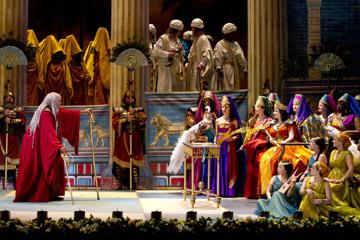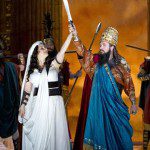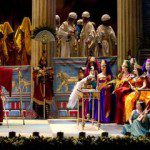We were almost late to the Washington National Opera premiere production of Giuseppi Verdi’s spectacular and inventive “Nabucco” last Saturday because our cab driver drove smack into the crowd scene surrounding the White House Correspondents’ Dinner at the Washington Hilton.
Rubberneckers hoping to see George Clooney or Lindsay Lohan lined parts of Connecticut Avenue in the beginning rain. We settled for “Nabucco,” aka Nabucodonosor, aka Nebuchadnezzar, plus his two daughters Fenena, the lovely, and Abigaille, the fierce, plus a host of Hebrews in captivity, a high priest of Baal and a cast of hundreds including a magnificent chorus.
I thought about the WHCD a little during the long course of “Nabucco” because director Thaddeus Strassberger (who also designed the sets) brought a two-edged sensibility to the production, a kind of showtime aspect as well a faithful presentation of the kind of opera for which Verdi was famous.
Strassberger’s main conceit or invention is to stage the opera as it might be seen on an opening night in Milan’s Teatro alla Scala on March 9, 1842, with the tuxedoed swells and their jeweled ladies in boxes watching from boxes, presaged by marching soldiers. He revisits the concept later in the opera when the stage is transformed, with a large, white-clad chorus assembling to sing the moving “Va, pensiero,” a musical piece so powerful that it became the unofficial national anthem of Italy once it achieved unification. Closer to the front of the stage, you can see a ballerina practicing, men and women milling at a table, and patrons of the time moving about.
This apparently approximated performance practices of the times–frequent intermissions, prologues, performances by ballet dancers, a kind of informality that was both grand and intimate.
Since “Va, pansiero” is a kind of longing, full-bodied lament on the part of the Israelites in captivity in Babylon for the lost homeland, one might think the business on the stage might distract from the plight. But the opposite takes hold–it becomes a moving, extended moment (which had echoes for a divided and occupied Italy), so moving that it is done again, with the hope that the audiences of the time might join in.
Historically, “Va, pansiero” is a highlight of any production of “Nabucco.” That was true for the WNO production, but Verdi’s music, so expansive and such a boon for the orchestra, draped itself over the principals, all of them in various degrees gifted with requisite vocal and acting skills. While several narrative strands emerge from the opera–there’s Nabucco’s calamitous, blasphemous destruction of Solomon’s Temple, the defeat and captivity of the Hebrews and the effect on their leaders — a love affair between one Fenena and a handsome Hebrew warrior, the anti-hero and anti-heroine of “Nabucco” are the Babylonian king and his low-born, grandly angry and resentful warrior daughter Abigaille.
While there are imposing vocals and star turns by bass Soloman Howard as a venomous high priest of Baal, Turkish bass Burak Bilgili as the Hebrew leader Zaccaria, French mezzo-soprano Geraldine Chauvet in a moving performance as Fenena and tenor Sean Panikar in heroic form as Ismael, the burden of the opera has to be carried by Italian baritone Franco Vassallo as Nabucco and Hungarian soprano Csilla Boross, as his usurping daughter as Abigaille. They occupy large chunks of this nearly three-hour opera, sometimes in cross-purposed, combative duets, sometimes by themselves, especially Vassallo as Nabucco moves in and out of madness alone in a prison cells. Boross hits the highest notes possible at the top of the scale in full rage, her bile and resentment boiling over, preceded by lower-level guile as she attempts to manipulate the king.
This is Verdi-style grand opera, of course, and not to be mistaken for history, per se, although the scale and sources are somewhat biblical–gods, the Babylonian Baal and the Hebrew Jehovah, are omni-present if not in the flesh. The production–subtle in some of its staging–also means to bowl you over with sheer grandiosity, and it succeeds. Mattie Ullrich’s diverse, eye-pleasing costume designs–the clean white of the Hebrews contrasts sharply with the rich, intricate, gold and greens of the Babylonian hierarchy, mixing in with more spectral presences and the 19th-century evocations of the on-stage onlookers.
“Nabucco” is being performed at the Kennedy Center’s Opera House through May 21.






